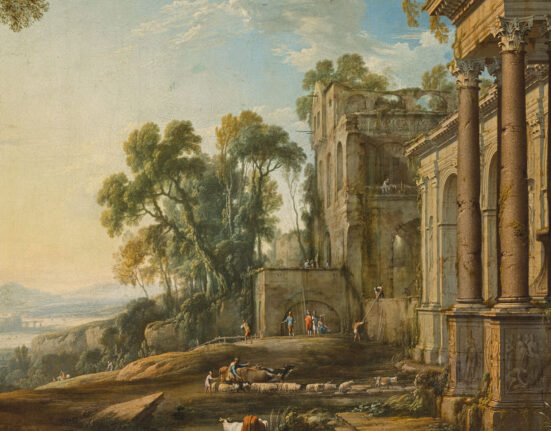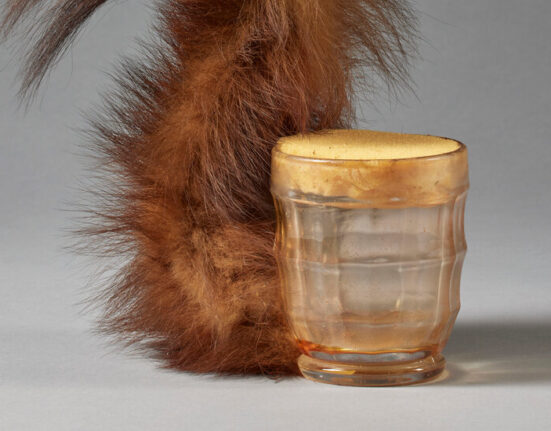A sense of abundance was palpable in more ways than one at the VIP opening of the 2023 edition of the European Fine Art Fair (TEFAF) in Maastricht, the Netherlands, on March 9–10. Kicking off the European art fair circuit, the encyclopedic art event, which runs until March 19, is back to its usual pre-pandemic timing and size, with over 270 exhibitors featuring Old Masters, antiques, jewelry, tribal art, modern and contemporary art, ancient art, and design.
In comparison to most other major art fairs, which almost exclusively focus on modern and contemporary art, the sheer amount of art history covered—some 7,000 years of artistic expression—is especially mind-boggling this year. The quality of jaw-dropping works on offer ranges from merrymaking drunkards in Brueghel’s crowded scenes and vibrant, dreamlike Chagalls to 17th-century trompe l’oeil, still-life masterpieces, often hung salon-style. As is tradition, TEFAF responded in kind for the preview days, with bubbling clouds made from bouquets of flowers foaming up to the ceiling and flowing champagne accompanied by seafood nibbles. For those lucky enough to snag tickets to the blockbuster, sold-out Vermeer exhibition in Amsterdam’s Rijksmuseum nearby, the dual events made for a thrilling exposure across centuries.
Additionally, for some visitors, TEFAF presents a more serious venue for seeing—and ultimately buying—high-caliber art, compared to some of its competitors. Sylvain Cordier, head of European art at the Virginia Museum of Fine Arts, contrasted TEFAF to Frieze LA where “so many people are taking selfies and Instagramming everything—that wouldn’t happen at TEFAF. We’re here to work,” adding that for his focus, “TEFAF is essential.”
TEFAF hasn’t had it easy since the onset of the pandemic. It’s 2020 edition was the last in-person fair of the year, closing early after confirmed Covid cases from visitors. After an online edition in 2021, the fair returned in-person last June with fewer exhibitors than previous editions. It was also victim to a jewelry heist, suspected to be the work of the notorious Pink Panthers.
TEFAF chairman Hidde van Seggelen told ARTnews that following last year’s unprecedented theft, where “people came with so much violence into our space,” security measures have been heightened, including metal detectors at the entrance and more security personnel. Other than London’s Symbolic & Chase, the exhibitor that was robbed, all regular jewelry dealers returned, which is “proof that people trust us,” Van Seggelen said.
Though last year’s heist made headlines, security wasn’t as major of a conversation on the fairgrounds as was issues regarding provenance, restitution, and looted antiquities—three connected concerns. TEFAF is renowned for its stringent vetting of provenance, which reassures buyers, but in recent years debates around restitution of artworks to former colonies, primarily in Africa, and Indigenous communities, as well as heightened awareness around the risks of dealing in looted antiquities, have ramped up. While antiquities dealers often go through great lengths to ascertain an object’s provenance, the mood at TEFAF wasn’t one pushing for speeding up restitution efforts or cracking down on the antiquities trade. Nevertheless, Martin Clist, a director at London’s Charles Ede gallery, London, which sells Egyptian and Greek antiquities, said that increased scrutiny did help eliminate dealers “on the edges of the market who were turning a quick buck without necessarily paying much attention to authenticity or provenance.”
Below, a look at the best booths at the 2023 edition of TEFAF.
-
Agnews Gallery, London
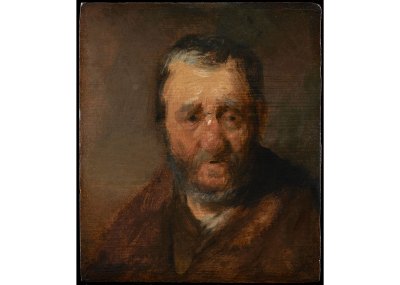

Image Credit: Courtesy Agnews Gallery Imagine being able to get right up close to a portrait that may very well be by Rembrandt. That is precisely the case at Agnews Gallery’s booth, where so far evidence suggests this portrait, believed lost for some 75 years and discovered recently, could be the real deal. Gallery co-owner Cliff Schorer made headlines in December when he announced his mission to prove its authenticity as a genuine Rembrandt. Existence of the painting was recorded before it went missing during WWII, when it was smuggled into the US by its owners and then sold. According to Schroer, it also survived the California Tea Fire in 2008, though its records burned.
While analysis by additional international experts remains to be done and Rembrandts have historically been faked, it was the talk of TEFAF. The portrait itself is engrossing, depicting an elderly man with a bewildered, pensive expression. Schorer identified the piece as a head study for “a fully autographed, universally accepted painting” by the Flemish master, David Playing the Harp for King Saul (ca. 1630), now in the collection of the Städel in Frankfurt. “There are very few autographed head studies that we know of from this very early period, so it’s really interesting to be able to look at new scholarship,” Schorer said.
-
Dickinson, London
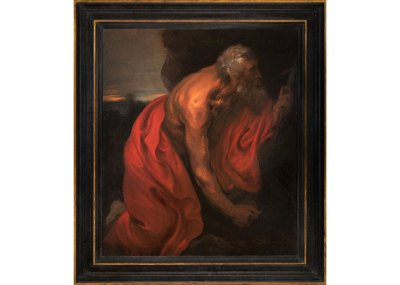

Image Credit: Courtesy Dickinson gallery At Dickinson’s booth is another newly discovered treasure: an early painting by Anthony van Dyck, dating to 1616–17, of Saint Jerome. Simon Dickinson, the gallery’s founder, told ARTnews the painting had been unnoticed and covered in dust and dirt in a private collection until about eight months ago. “It was obvious to me that it was by Van Dyck,” he said, noting that it likely hadn’t been cleaned in 200 years. “He painted a few other paintings by the same date of Saint Jerome that I know very well. It was painted exactly the same way.” Though Dickinson wouldn’t divulge how much he paid for the work sold at a small auction in France, he said it was far less than the €700,000 he’s now asking for it.
-
Zebregs & Röell, Maastricht and Amsterdam
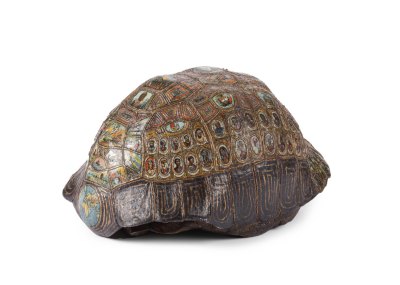

Image Credit: Photo Michiel Elsevier Stokmans/Courtesy of Zebregs & Roell Featured in the Showcase section for young galleries, Zebregs & Röell drew a steady stream of curious visitors to their curated selection of “cross-cultural” works of art from various colonial eras, which gallery co-owner Dickie Zebregs said “show the influence of different cultures, in our case, a one-sided, mostly European influence, but we don’t mind telling the dark side of the story to these pieces.” Among those objects is a late 19th-century tortoise shell painted with tiny portraits of individuals from all over the world, as well as replicas of romantic masterpieces, and some inlaid jewels.
There is also a sturdy, unassuming, large wooden trunk with brass mounts that the gallery said is the oldest known piece of furniture made in North America by European colonists. Parts of so-called Anneke Jans Chest were made by different craftsmen in different parts of the world, before ending up in New Amsterdam by the 1630s. Norweigan Anneken Jans Bogardus, who boarded a ship to North America in 1630, traded with local Indigenous tribes, and earned enough money to buy the chest with the profits, which were likely magnified due to the slaves she likely owned, according to Zebregs.
-
Elliott Fine Art, London
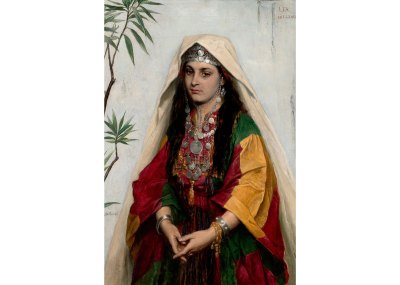

Image Credit: Courtesy Elliott Fine Art Also in Showcase, Elliott Fine Art has a stand-out booth featuring arresting 19th-century portraits, including depictions of women in all their complexity. Lea, a Bride from Bethlehem by Albrecht de Vriendt (1843–1900) is a highlight. A very young bride in Bethlehem poses for the artist, who beautifully captures her apparently dispirited feelings about her impending nuptials. Her bridal costume is also done with minute accuracy. “With Orientalism, one of the hazards is that it shows people who are exoticized, generic, and I want to avoid that. I’m more interested in portraits of real people who have sat in front of the artist, and that idea of human connection,” said gallery founder Will Elliott, who added that the painting was acquired by an American institution.
-
Oscar Graf, London and Paris
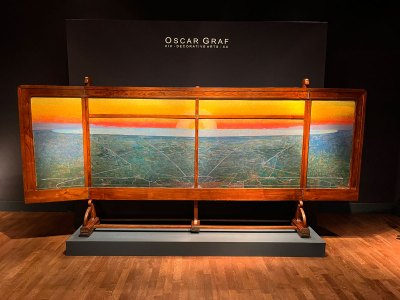

Image Credit: Courtesy Oscar Graf Dealer Oscar Graf is featuring a show-stopping, avant-garde wooden room divider painted in 1902 by Italian artist Giuseppe Viner. The vibrant, colorful triptyque depicts the sun setting or rising over the Tuscan landscape in the Italian Divisionist style. Graf said he chose to feature an all-Italian booth because he felt the country’s artists from the turn-of-the-20th-century period were neglected by museums, “when in fact there were so many different styles and people. It was a very recently unified country, so there was a lot of diversity, and regional strength, as opposed to everything being centered in Rome,” Graf said. He said Viner moved to a tower in a small village outside of Sienna, where he probably made the room divider for himself, adding that it was “the most extraordinary thing he did in his career.”
-
Sean Kelly, New York and Los Angeles


Image Credit: Photo Pieter de Vries/Courtesy Sean Kelly Contemporary art is intermingled in TEFAF’s marquee fair, though it is largely limited to large-scale works by established artists, like Kehinde Wiley. For Sean Kelly’s inaugural participation in the fair, the gallery presented three works by the artist. Wiley is famed for taking iconic history paintings and portraits of wealthy sitters and reconfiguring them with portraits of Black and Brown men and women, a fitting creative method for a fair weighted toward art history. His monumental Portrait of Tarek Ali Ellis and Michael Morgan (2023) shows Ellis, an American YouTuber, in a light blue denim jumpsuit, gazing stoically at the viewer, while holding Morgan, lain over the former’s lap in a pietà pose as he also stares the viewer.
-
Kamel Mennour, Paris
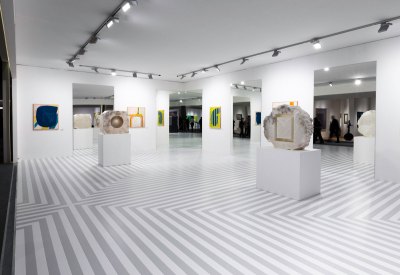

Image Credit: Photo David Owens/Courtesy the artists and Mennour, Paris French dealer Kamel Mennour also said he was particularly interested in the shock-effect of transitioning from Old Masters to “my time period, contemporaneous life, something that is a whole work in itself.” He invited artists Daniel Buren and Anish Kapoor to collaborate on an immersive installation for the gallery’s booth. Buren designed an alternating, gray- striped floor that is accented with large mirrors hung in alternating rows on the walls to show off seven 1965 paintings that have not been previously exhibited. For his part, Kapoor presents three massive sculptures—two in alabaster one in granite—that hold down this stark jump into endless, shifting line and perspectives.
-
Daniel Crouch Rare Books, London and New York
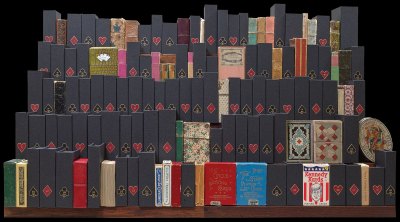

Image Credit: Courtesy Daniel Crouch Rare Books, London and New York Another highly buzzed about display at TEFAF was a collection of some 160 decks of playing cards dating from the 1670s to the 1990s. Amassed over 40 years by Dutch banker Frank van den Bergh, they feature decorated, satirized characters, where the suits often transform into strange things, like animals or body parts. A fragment of one, so-called “foundling card,” tells a particularly heart-wrenching story. Mothers who could not keep their babies in the 18th century would tear a playing card unevenly, keep one part, and leave the other with the foundling. If ever the two pieces were brought back together and the pieces fit, it meant the mother and child had been reunited. On the back of the foundling card on view at the fair, there is a note written in ink: “My burden is heavy, goodbye my dear Femke, Born 1st September 1795.”




